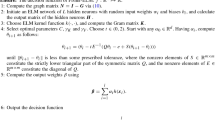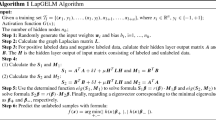Abstract
Semi-supervised extreme learning machine (SSELM) was proposed as an effective algorithm for machine learning and pattern recognition. However, the performance of SSELM heavily depends on whether the underlying geometrical structure of the data can be well exploited. Though many techniques have been utilized for constructing graph to represent the data structure, which of them can best reflect the intrinsic distribution of complicated input data is still needed to be verified. Aiming to solve this problem, we propose a novel algorithm called adaptive multiple graph regularized semi-supervised extreme learning machine (AMGR-SSELM). The contributions of the proposed algorithm are as follows: (1) AMGR-SSELM employs multiple graph structures extracted from training samples to characterize the structure of input data. Since these graphs are constructed based on different principles and complementary with each other, the underlying data distribution can be well exploited through combining them. (2) A nonnegative weight vector is introduced into AMGR-SSELM to adaptively combine the multiple graphs for representing different data. (3) An explicit classifier can be learnt in our algorithm, which overcomes the ‘out of sample’ problem. (4) A simple and efficient iterative update approach is also proposed to optimize AMGR-SSELM. In addition, we compare the proposed approach with other classification methods and some extreme learning machine variants on five benchmark image databases (Yale, Extended YaleB, CMU PIE, AR and FKP). The results of extensive experiments show the advantages and effectiveness of the proposed approach.




Similar content being viewed by others
References
An S, Liu W, Venkatesh S (2007) Face recognition using kernel ridge regression. In: Proceeding of IEEE international conference on computer vision
Bengio Y, Paiement J, Vincent P (2003) Out-of-sample extensions for LLE, isomap, MDS, eigenmaps and spectral clustering. In: Proceedings of advances in neural information processing systems, pp 177–184
Boyd S, Vandenberghe L (2009) Convex optimization. Cambridge University Press, New York
Cai X, Nie X et al (2013) Heterogeneous image features integration via multi-modal semi-supervised learning model. In: 2013 IEEE international conference on computer vision (ICCV). IEEE, pp 1737–1744
Cambria E et al (2013) Extreme learning machines trends & controversies. IEEE Intell Syst 28(6):30–59
Cao J et al (2016) Extreme learning machine and adaptive sparse representation for image classification. Neural Netw 81:91–102
Cheng B, Yang J et al (2010) Learning with 11-graph for image analysis. IEEE Trans Image Process 19(4):858–866
Deng W et al (2016) A fast SVD-hidden-nodes based extreme learning machine for large-scale data analytics. Neural Netw 77:14–28
Ding S, Zhang N et al (2017) Unsupervised extreme learning machine with representational features. Int J Mach Learn Cybern 8(2):587–595
Duda R, Hart P, Stork D (2012) Pattern classification. Wiley, New York
Gastaldo P et al (2016) SIM-ELM: connecting the elm model with similarity-function learning. Neural Netw 74:22–34
He X, Niyogi P (2005) Locality preserving projections. Adv Neural Inf Process Syst 16(1):186–197
Huang G, Chen L (2008) Enhanced random search based incremental extreme learning machine. Neurocomputing 71(16):3460–3468
Huang G, Chen L, Siew C (2006a) Universal approximation using incremental constructive feed forward networks with random hidden nodes. IEEE Trans Neural Netw 17(4):879–892
Huang G, Zhu Q, Siew C (2006b) Extreme learning machine: theory and applications. Neurocomputing 70(1):489–501
Huang G et al (2015a) Trends in extreme learning machines: a review. Neural Netw 61:32–48
Huang G, Bai Z et al (2015b) Local receptive fields based extreme learning machine. IEEE Comput Intell Mag 10(2):18–29
Iosifidis A, Tefas A, Pitas I (2015) Graph embedded extreme learning machine. IEEE Trans Cybern 46(1):311–324
Karasuyama M, Mamitsuka H (2013) Multiple graph label propagation by sparse integration. IEEE Trans Neural Netw Learn Syst 24(12):1999–2012
Kasun L, Yang Y et al (2016) Dimension reduction with extreme learning machine. IEEE Trans Image Process 25:3906–3918
Lee K, Ho J, Kriegman D (2005) Acquiring linear subspaces for face recognition under variable lighting. IEEE Trans Pattern Anal Mach Intell 27(5):684–698
Li P, Bu J et al (2013) Relational multimanifold coclustering. IEEE Trans Cybern 43(6):1871–1881
Liang N, Huang G, Saratchandran P (2006) A fast and accurate online sequential learning algorithm for feedforward networks. IEEE Trans Neural Netw 17:1411–1423
Liu G, Lin Z, Yu Y (2010) Robust subspace segmentation by low-rank representation. In: International conference on machine learning, pp 663–670
Liu G, Lin Z et al (2013) Robust recovery of subspace structures by low-rank representation. IEEE Trans Pattern Anal Mach Intell 35(1):171–184
Liu M, Liu B et al (2017) Semi-supervised low rank kernel learning algorithm via extreme learning machine. Int J Mach Learn Cybern 8(3):1039–1052
Lu C, Min H et al (2012) Robust and efficient subspace segmentation via least squares regression. In: European conference on computer vision, pp 347–360
Mao W, Wang J, Xue Z (2017) An ELM-based model with sparse-weighting strategy for sequential data imbalance problem. Int J Mach Learn Cybern 8(4):1333–1345
Martinez A, Benavente R (1998) The AR face database, CVC technical report, vol 24
Naseem I, Togneri R, Bennamoun M (2010) Linear regression for face recognition. IEEE Trans Pattern Anal Mach Intell 32(11):2106–2112
Peng Y, Wang S et al (2015) Discriminative graph regularized extreme learning machine and its application to face recognition. Neurocomputing 149:340–353
Peng X et al (2017) Constructing the L2-graph for robust subspace learning and subspace clustering. IEEE Trans Cybern 47(4):1053–1066
Qiao S, Tang C et al (2010) PutMode: prediction of uncertain trajectories in moving objects databases. Appl Intell 33(3):370–386
Qiao S, Han N et al (2015a) TraPlan: an effective three-in-one trajectory-prediction model in transportation networks. IEEE Trans Intell Transp Syst 16(3):1188–1198
Qiao S, Shen D et al (2015b) A self-adaptive parameter selection trajectory prediction approach via hidden Markov models. IEEE Trans Intell Transp Syst 16(1):284–296
Qiao S, Han N et al (2017) Predicting long-term trajectories of connected vehicles via the prefix-projection technique. IEEE Trans Intell Transp Syst. https://doi.org/10.1109/TITS.2017.2750075
Qiao S, Han N et al (2018) A fast parallel community discovery model on complex networks through approximate optimization. IEEE Trans Knowl Data Eng. https://doi.org/10.1109/TKDE.2018.2803818
Remmert R (2012) Theory of complex functions. Springer, Berlin
Rong H, Huang G, Sundararajan N (2009) Online sequential fuzzy extreme learning machine for function approximation and classification problems. IEEE Trans Syst Man Cybern B 39:1067–1072
Roweis S, Saul L (2000) Nonlinear dimensionality reduction by locally linear embedding. Science 290(5500):2323–2326
Rumelhart D, Hinton G, Williams R (1986) Learning representations by back-propagating errors. Nature 323(9):533–536
Salaken S et al (2017) Extreme learning machine based transfer learning algorithms: a survey. Neurocomputing 267:516–524
Tang J, Deng C, Huang G (2016) Extreme learning machine for multilayer perceptron. IEEE Trans Neural Netw Learn Syst 27(4):809–821
Terence S, Simon B, Maan B (2003) The CMU pose, illumination, and expression (PIE) database. IEEE Trans Pattern Anal Mach Intell 25(12):1615–1618
Wang J, Bensmail H, Gao X (2013) Multiple graph regularized nonnegative matrix factorization. Pattern Recognit 46(10):2840–2847
Wang Z et al (2017) Kernel fusion based extreme learning machine for cross-location activity recognition. Inf Fusion 37:1–9
Wright J, Yang AY et al (2009) Robust face recognition via sparse representation. IEEE Trans Pattern Anal Mach Intell 31(2):210–227
Yale University Face Database (2002). http://cvc.yale.edu/projects/yalefaces/yalefaces.html. Accessed 10 Dec 2002
Yang B, Chen S (2010) Sample-dependent graph construction with application to dimensionality reduction. Neurocomputing 74(1):301–314
Yang L, Yang S et al (2017) Incremental Laplacian regularization extreme learning machine for online learning. Appl Soft Comput 59:546–555
Yao L, Ge Z (2018) Deep learning of semi-supervised process data with hierarchical extreme learning machine and soft sensor application. IEEE Trans Ind Electron 65(2):1490–1498
Yi Y, Zhou W et al (2014) Face recognition using spatially smoothed discriminant structure-preserved projections. J Electron Imaging 23(2):023012-1-20
Yi Y, Bi C et al (2015a) Semi-supervised local ridge regression for local matching based face recognition. Neurocomputing 167:132–146
Yi Y, Shi Y et al (2015b) Label propagation based semi-supervised non-negative matrix factorization for feature extraction. Neurocomputing 149:1021–1037
Yu J, Wang M et al (2012) Semi-supervised multiview distance metric learning for cartoon synthesis. IEEE Trans Image Process 21(11):4636–4648
Zhai J, Zhang S, Wang C (2017) The classification of imbalanced large data sets based on mapreduce and ensemble of elm classifiers. Int J Mach Learn Cybern 8(3):1009–1017
Zhang L, Zhang D (2016) Robust visual knowledge transfer via extreme learning machine-based domain adaptation. IEEE Trans Image Process 25(10):4959–4973
Zhang L, Zhang D (2017) Evolutionary cost-sensitive extreme learning machine. IEEE Trans Neural Netw Learn Syst 28(12):3045–3060
Zhang L, Zhang L et al (2010) Online finger-knuckle-print verification for personal authentication. Pattern Recognit 43(7):2560–2571
Zhang L, Yang M, Feng X (2011) Sparse representation or collaborative representation: which helps face recognition? In: Proceeding of IEEE international conference on computer vision, pp 471–478
Zhang Z, Zhao M, Chow TWS (2015) Graph based constrained semi-supervised learning framework via label propagation over adaptive neighborhood. IEEE Trans Knowl Data Eng 27(9):2362–2376
Zhang B et al (2018) Ensemble based reactivated regularization extreme learning machine for classification. Neurocomputing 275:255–266
Zhou D et al (2004) Learning with local and global consistency. Adv Neural Inf Process Syst 16:321–328
Zhou Y, Liu B et al (2015) Semi-supervised extreme learning machine with manifold and pairwise constraints regularization. Neurocomputing 149(PA):180–186
Acknowledgements
This study was supported in part by the National Natural Science Foundation of China under Grants Nos. 61602221, 61772091, 61672150, 61602222 and 61702092; the Natural Science Foundation of Jiangxi Province under Grant No. 20171BAB212009; the Planning Foundation for Humanities and Social Sciences of Ministry of Education of China under Grant No. 15YJAZH058; the Innovative Research Team Construction Plan in Universities of Sichuan Province under Grant No. 18TD0027; the Scientific Research Foundation for Advanced Talents of Chengdu University of Information Technology under Grant Nos. KYTZ201715 and KYTZ201750; the Scientific Research Foundation for Young Academic Leaders of Chengdu University of Information Technology under Grant No. J201701.
Author information
Authors and Affiliations
Corresponding authors
Ethics declarations
Conflict of interest
The authors declare that they have no conflict of interest.
Ethical approval
This article does not contain any studies with animals performed by any of the authors.
Informed consent
Informed consent was obtained from all individual participants included in the study.
Additional information
Communicated by X. Wang, A.K. Sangaiah, M. Pelillo.
Rights and permissions
About this article
Cite this article
Yi, Y., Qiao, S., Zhou, W. et al. Adaptive multiple graph regularized semi-supervised extreme learning machine. Soft Comput 22, 3545–3562 (2018). https://doi.org/10.1007/s00500-018-3109-x
Published:
Issue Date:
DOI: https://doi.org/10.1007/s00500-018-3109-x




